The majority of turf diseases are caused by fungal pathogens but some fungi are more strongly pathogenic than others. Many of the common cool season turf diseases are caused by fungi that rely on a weakened plant and therefore reducing disease incidence and severity is often aligned to maintaining a strong sward. With on-going changes to European Legislation relating to pesticide use, it is more important than ever that an integrated approach to disease management is employed and central to this is an understanding that the cultural conditions can limit disease development. Making use of the genetic variation that exists between grass types and cultivars can also minimise disease development through a sward. By managing rootzone quality and using weather information services, it can also be possible to pre-empt disease outbreaks and plan an efficient integrated management strategy.
Pathogen: Sclerophthora macrospora
Susceptible Species: Predominantly Bentgrasses (Agrostis spp.) and Annual Meadow Grass (Poa annua) but all cool season grasses can also be occasionally attacked. This disease is commonly associated with poor drainage and large areas of disease are often seen on low-lying and poor-draining sections of golf greens.
Yellow Tuft is not a common site on UK turf, but is seen in spring and autumn following heavy rain or during dry spells in summer when over-watering can occur via inefficient irrigation systems.
Although still rare, it is becoming more common and, if left unchecked, outbreaks can lead to unsightly damage. Sclerophthora macrospora is an obligate parasite; this means it will remain alive within affected plant tissues, but will only become visible and start to cause blemishes to the sward when the climate becomes conducive to disease development – i.e. damp, water-retentive surfaces and warm/mild temperatures.
Cultural & Chemical Prevention:
Cultural prevention is all about managing soil moisture. Disease development is encouraged by lingering wet surfaces. This could come through a dense thatch layer, poor irrigation uniformity over-watering certain areas of turf, low-lying dips and hollows with poor drainage that hold onto moisture, areas near leaking sprinkler heads that are constantly soaked night after night, lower areas that surface water runs across regularly, etc. Whatever the reason for the high levels of moisture, it needs to be addressed or the problem will never be permanently solved.
There is no chemical treatment available for Yellow Tuft in the UK. In the short-term an application of a penetrant wetting agent such as HydroFlo or AquaRapido™ will aid penetration of water down through the rootzone. Where thatch is an issue a programme of aeration, top dressing and thatch-digesting products such as Growth Products DeThatcher have proved very successful on a number of golf courses throughout the UK.
Where symptoms occur due to irrigation problems during a dry spell, a full irrigation audit would be beneficial. This will tell you where water is being oversupplied to your turf and will highlight what work needs to be done to ensure even coverage. In the short-term focus on only using automatic systems when necessary and try to use a moisture meter and hand watering (where staffing levels allow) to even out soil moisture and keep it as low as possible that will maintain healthy plants.
If you have no issues with thatch, yet still have surface water issue during periods of high rainfall you need to identify what needs to be done to ensure water percolates through the surface AND has somewhere to go once it gets into the rootzone (e.g. pipe drains).

Example of Yellow Tuft
Symptoms
Initial symptoms can easily be confused with Leaf Spot; reddish-brown blemishes on the leaf and nothing else to indicate Yellow Tuft. Once the disease becomes established, the symptoms of rapidly increased tillering can be seen and the whole leaf turns a pale green and then yellow in small spots usually no larger than 2-4cm across, but these can coalesce to form larger patches.
Infected plants tend to have very poor root development and can be plucked from the sward with little effort. The overall appearance of the sward can be become very mottled with the light spots looking tufted and weak:

Non-Pesticidal Yellow Turf Prevention
- Identify drainage issues and remedy
- Identify thatch issues and remedy
- Identify irrigation issues and remedy
These are three fundamental issues. Control of soil moisture, whether deficiency or excess, is the key to ALL turf management. If you see any of the above three issues it is a sign that without remdial work to fix the underlying issue, you will always come up against problems when preparing turf.
Yellow Tuft is not the most damaging turf disease

